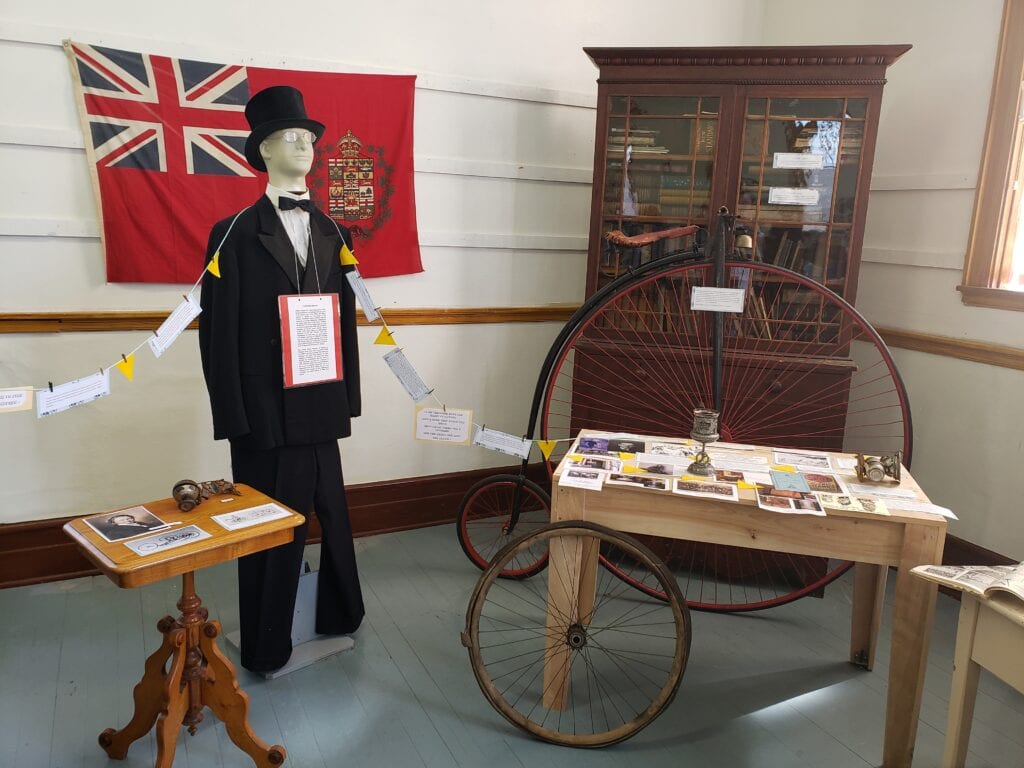By Sarah Kasprzak
for the West Hants Historical Society
But you’ll look sweet
“Daisy Bell”, Harry Dacre, 1892
Upon the seat
Of a bicycle built for two
When I had the idea to pull together an exhibit on cycling in Windsor, I honestly wasn’t even aware of how strong the ties are between our community and the history of bicycling. I thought we might find some neat pictures of people riding around the streets of the town from back in the day, maybe an article from a race or two, a little connection here or there, but nothing too exciting.
Wow, was I surprised!
Though the bicycle got its start overseas in Europe, it quickly landed right here in Nova Scotia, in the hands of the son of Mr Poole, the owner of the Caledonia Mine. By 1868, cycling had made its mark on the province – largely thanks to the Hanlon Brothers of New York and their travelling bicycle show. The bicycles rapidly gaining popularity in these days (called velocipedes) were very different from those we are familiar with today, though – the design at the time was incredibly heavy, rigid, and had no pedals, meaning it was incredibly difficult and uncomfortable to ride, which is why it aptly received the nickname ‘boneshaker’ in North America.
As bicycle popularity in Windsor continued to grow, so did the evolution of the contraption itself.
Slowly, as these contraptions became more and more popular, their design evolved. First, the crossbar became more sloped to accommodate larger wheels. Then, pedals were added, which was likely the most important and transformative addition to the design. That being said, the next major change is definitely the most visually recognizable – the sudden introduction of the high wheel bicycle. The infamous penny farthing design was adapted, believe it or not, was to make it easier to ride quickly! I was so charmed to find the etymology of that common term for them: in British currency of the era, the penny was a much larger coin than the farthing, meaning if you were to place a penny and a farthing next to each other, they would mimic the high and short wheels of a bicycle, respectively. Because the chain system hadn’t yet been added to the pedals, pedaling meant pulling yourself forward by a wheel far in front of your center of gravity rather than using your weight to propel yourself along. These high wheel bicycles swept both Halifax and Windsor with their sudden rise in popularity, which led to the creation of several cycling clubs, such as the Avonian. Bicycles were new, exciting, dangerous, interesting to look at, and fast – the perfect recipe for a new town craze. One of my favourite parts of doing research for this exhibit was my visit to Shand House, a lovely historically-preserved home (now museum) that was the residence of Clifford Shand, a cycling legend from the height of the craze back in 1890 here in town, who dominated the competition as part of the Avonian Cycle Club, winning the majority of races in which he participated and acting as a core proprietor of local cycle culture.
As bicycle popularity in Windsor continued to grow, so did the evolution of the contraption itself. We now arrive at a design that will likely look familiar – the safety bicycle. Now not only were bicycles safer and easier to ride for those who already had that privilege, but others could as well! Up until this most recent modification, cycling was a hobby mostly reserved for young, fit, well-off men – the safety bicycle immediately allowed women, children, and those who were less physically ambitious to join in on the fun. This marked a sizable milestone in women’s liberation: cycling was an independent way for women to get around that allowed them to have their own social gatherings and agenda out of the home, as well as to modify stuffy victorian dress that had previously restricted their lifestyle dramatically.
The most amazing part of diving into cycling history in Windsor was not the actual invention or culture itself, but how it impacted the culture of where we live.
It’s not hard to spot the safety bicycle design today – one of the easiest places to find them is in the bicycle parking in front of the Spoke and Note, and incredible family-owned small business in our community that is one of the main reasons cycling thrives in Windsor to this day. I interviewed Tony Wood about what it’s like to be at the centre of this amazing collective of people, repairing bikes, helping folks pick out their new gear, organizing events and group rides, supporting other local businesses, and getting people outside, active, and having a good time. It’s evident that the Wood family are passionate about what they do and the community they’ve cultivated, and I think I speak for all of Windsor when I say we are lucky to have them around!
The most amazing part of diving into cycling history in Windsor was not the actual invention or culture itself, but how it impacted the culture of where we live. It started out by inspiring excitement as a brand new invention that sounded too crazy to be true. It gained momentum (literally), brought people together, and became more than a mode of transportation: it became a lifestyle, a community, a piece of what we call ‘home’. So, next time you’re headed out for a walk or to run errands, consider following along with well over a hundred years of local history and hopping on your bike!

